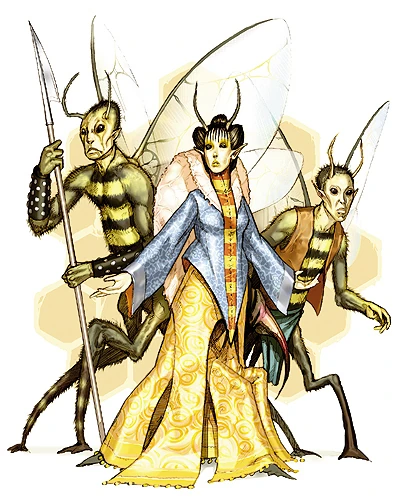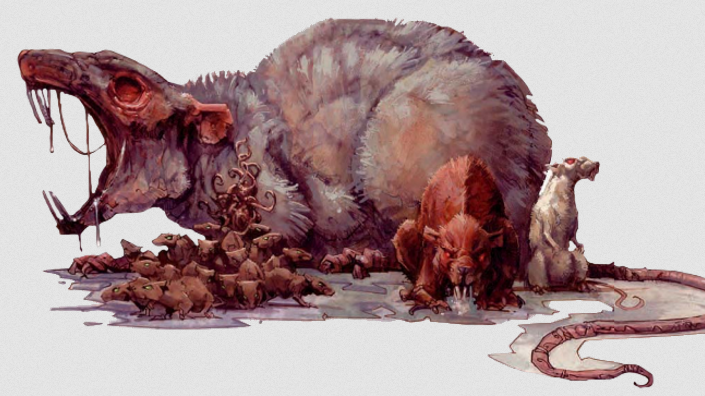DISCUSSING
In the Shadow of the Spire – Session 42A: Rat Mothers
But Ranthir, upon hearing the word “flee”, whirled around and webbed the far side of the room: The mothers, the albino, and Berq were all helplessly caught – except for one mother, trapped in the corner, who futilely screamed for help in her despair. Tor closed on her and ruthlessly killed both her and the baby ratlings.
With the other mothers still trapped in the web. Tee was able to broker a bargain in which they would be freed if one of them would lead the party to the southern sewer entrance. While the mothers were carefully freed from the web, Tor started discreetly taking ears and fingers from the dead as trophies. Meanwhile, Elestra distracted the ratlings with small talk to keep them from noticing Tee looting the coffers of the nest master (which were filled with gems, jewelry, and large amounts of coin; although given the bones and skulls dangling from the ceiling, Tee didn’t want to spend too much time thinking about where it had all come from).
“Killing orc babies” in D&D is a trope not so much because DMs are deliberately trying to present their players with this moral dilemma, but rather because it arises pretty naturally out of the standard D&D adventure type: Dungeons inhabited by X. “Inhabited” leads to community; community leads to babies. And, of course, it’s not just orcs. In this session it happened to be ratlings.
Now, there’s a whole discussion to be had about the colonialist themes in D&D and also the degree to which the traditional fantasy tropes of “species which is inherently evil” and/or “humanoid species with sub-human intellects” are manifestations of and/or informed by real world racism, but I’m going to put a pin in that.
What I’m focused on at the moment is less the specific moral dilemma, and rather the phenomenon of emergent moral dilemmas.
There can sometimes be the impression that moral dilemmas are something that GMs need to specifically create, frame up, and present to the players. But the real world is filled with moral dilemmas with nary a GM in sight, so it’s not really surprising that they’ll also crop up more or less unbidden in our simulated game worlds – whether that’s ratling babies in the ratling nests; the decision to betray a friend; or the opportunity to profit at the expense of others.
Whether a particular moral dilemma is crafted by a GM or emerges from the narrative of play, it can offer a rich opportunity for roleplaying, allowing players to explore their characters at a deep and meaningful level. Like any form of play, it can also be a way to safely explore complex issues.
Or, alternatively, being a form of play, it can also provide an escape from the complexities of the real world.
This is where moral dilemmas can create strife at your table: When some players are approaching the game world as a place of deep meaning and other players are approaching the game world as an ephemera of casual play, this can easily create discordant perceptions. To some extent, of course, this is always true, but when it comes to moral dilemmas, the inherently heightened takes – e.g., killing babies! – will naturally amplify the discordance.
(The issues of how much a player’s actions/beliefs are separated from their character’s actions/beliefs also complicates this, but I’m going to put a pin in that, too.)
Not only will different players have different responses to these situations, the same player can easily have a different response depending on the nature and context of the moral dilemma.
To use a video game analogy, I’ve never seen anyone seriously object to Mario curbstomping koopas to death, but change the context to running down pedestrians in Grand Theft Auto and now there are many people who would find it distasteful. But some of the people who object to running down pedestrians have no problem with stealing cars in the same game! Others who will happily go on mass murder sprees in the game will draw the line at running over a sex worker you just paid so that your character can get the money back.
Why?
Because people are complicated.
In the case of the ratling babies in my own campaign, what happened was a combination of several factors:
- A general coarsening of the group’s morality in the face of hardships. (Something which has been commented on several times in recent sessions.)
- The perceived moral positioning of ratlings, with some of the players/characters perceiving them as being more like worgs or cannibalistic apes than human-equivalent sentients.
- The moral importance of the game world. The group was largely on the same bandwidth here, but there were definitely some players with a slightly more casual approach.
Because the players were mostly in alignment with each other – and also because they all had the same clear understanding that character actions were not player actions – these factors kind of balanced each other out: While one player might be slightly more cavalier than another, a player who was taking the world a little more seriously could nevertheless interpret those actions as being consistent with the other character “losing their moral compass,” and it would all sort of muddle out in a collective experience everyone was happy with.
Of course, this will not always be the case! It’s quite possible for disparate reactions to a moral dilemma to cause serious strife!
And the broader point is that, because moral dilemmas will naturally emerge from your narrative, you can’t dodge this issue by just saying, “Well, I just won’t include any moral dilemmas in the campaign, then.” You need to be aware and stay aware of what’s happening at your game table, and when player expectations get out of alignment you need to be prepared to hit the pause button and help everyone get back on the same page.
Safety tools – i.e., structures for having these conversations in clear and productive ways – are obviously helpful with this, and I particularly recommend using them if you’re playing with someone for the first time or with familiar players in a new genre. But a lot of safety tools are focused on identifying topics or themes, and moral dilemmas can often hit the group from unexpected angles and in unanticipated ways. So keep your eyes open!
Campaign Journal: Session 42B – Running the Campaign: Scouting Dungeons
In the Shadow of the Spire: Index


















